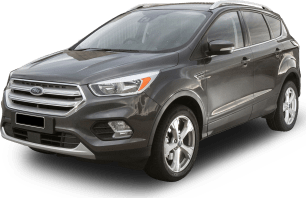The Tiguan Allspace is the only seven-seat SUV in Volkswagen’s current line-up. Yes, the big Touareg SUV flagship is 10cm longer but in Australia we get the five-seater version. And yes, there is a real possibility that in the coming years another Volkswagen SUV known as the Atlas (USA) and Teramont (Europe/Asia) with seven seats could come, but for now the Allspace is carrying the responsibility all on its own.
So, does it do a good job of being a seven-seater? Yes, as long as those in the third row are younger children because even my colleague who is not the tallest adult at 175cm found those back seats to be cramped in both head and legroom.
I’m a 191cm tall and the only way I could sit with my legs not touching the seat back was by sliding the second row forward as far as it goes which left no legroom for anybody in front of me. The limited headroom back there meant I also had to hunch.
But if your kids are as tall as me, then it might be time for them to get their own car or think about a Volkswagen Transporter (if you’re a fan of the brand) which are proper people movers that accommodate at least seven and with enormous amounts of room even for freaks like me.
Second row legroom in the Allspace is outstanding. I can sit behind my driving position with about 50mm of room between my knees and the seat back and headroom is excellent, too – seriously another whole entire Richard Berry could sit on my lap and still be comfortable. Okay, that’s weird.
Look at the size of those rear doors in the images. They are as big as the ones on a bank vault. When you compare them to the regular Tiguan’s back doors you can see where the extra length has gone in creating the Allspace and the size of the opening makes getting in and out of the second row easy.
Entry into the third row is helped by those large door apertures, but it seems because this SUV was designed originally with left-hand drive markets in mind the second row splits 60/40 so that the smaller section is on our roadside and not our kerb. It’s no biggie, but it’s just not as easy to slide the larger section forward.
With the second-row seats in use there’s still 230 litres of boot space – enough for a set of golf clubs (as demonstrated by Volkswagen at the car's launch). But if, like me, you don’t play golf that means about as much as saying you could fit 10 chihuahuas in there, so be assured there was enough room two soft overnight bags or maybe just look at the bad photo I took on my phone.
With those rear seats folded flat boot space in the Tiguan Allspace is excellent at 700 litres which is 75 litres more luggage capacity than the regular Tiguan and makes the size of the Santa Fe’s 547 litre cargo area look tiny.
Under the boot floor is a storage area for the cargo cover and under that compartment is the space saver spare wheel. Hooks, hard plastic bins for muddy shoes or wet swimmers and a torch can also be found in the boot.
Coming standard on the Allspace is a power tailgate with kick access, too – it only took me two kicks to open it but I’m uncoordinated, as you can clearly see in the video above.
Storage and utility throughout the cabin is unbeatable for this segment, with overhead luggage boxes galore, there are giant pockets in all the doors, two fold-down tables in the second row with a cupholder each.
There are another two cupholders in the rear centre armrest, another in the third row, two more up front in the cockpit, a dash-top covered box, and a deep centre console bin under the armrest. And that’s on all grades – the entry level Comfortline comes with more storage in the form of drawers under the driver and front passenger seats. All come with a glove box, too which adds more concealed storage and a CD player. Yes, a CD player – that makes me happy.
There are three USB ports on-board (two up front and one in the second row) and three 12-volt power supplies (front, second row and cargo area).
Hugely practical, but not great for carrying seven adults, think of the Tiguan Allspace as a five-seater with one of the biggest boots in the class and the flexibility to carry a couple of extra kids if you have to.






.png)














































.png)





















 copy.png)














